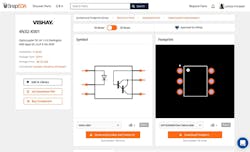Have you created a PCB footprint and schematic symbol from scratch for a component that you needed in your hardware design?
Schematic and printed-circuit-board (PCB) design tools come with a wide range of component models and schematic symbols. Most can be customized and utilized with new components, but this takes time and effort. This is especially true when it involves 3D models, simulation information, and so on. This level of functionality may not be needed for a basic PCB layout. However, it becomes invaluable when doing advanced analysis such as thermal simulations.
Managing a large library of components can also be a challenge. Building and maintaining this library becomes much easier if component information is provided by a third party instead of having to be created or recreated. Component vendors often provide this information in one form or another and there are a number of standard exchange formats, but no single format provides all of this information or is used by all tools.
1. SnapEDA’s website allows designers to search for components and then examine the details from schematic diagrams to 3D models.
SnapEDA is a website that helps simplify the chore of designing a system with new components. It provides free schematic models, PCB footprints, and 3D models for a growing list of electronic components. Designers can simply search for a part on the website and then check out the details (Fig. 1).
Developers can download information to a range of platforms, including Eagle, Altium, KiCad, OrCAD, Cadence Allegro, Pulsonix, and PADS. Such functionality highlights the value of SnapEDA. Vendors may provide one or more formats, but SnapEDA handles conversion to other formats. It also delivers the proper content to developers.
Users can also view details like the 3D models (Fig. 2). As noted, 3D outline and PCB layout details are just part of the information mix users are able to access. Datasheets and even product availability from a number of sources is available with most parts. It’s also possible to purchase parts from a wide selection of partners like Digi-Key, Arrow, and Mouser, or directly from some vendors. The website even provides average pricing and what parts are popular in current designs.
2. In addition to schematic and 2D PCB footprints, SnapEDA offers 3D models.
SnapEDA’s verification checker is a tool that gets applied to new components. It checks for manufacturing issues such as, for instance, the silkscreen doesn’t overlap pads in the PCB information. Not all components have been checked, since new components are always being added. It’s possible to request a check on a part if it hasn’t already been done. The checker’s “report card” for a component is available with the other information about a part, e.g., the datasheet and schematic symbol.
Of course, SnapEDA’s large database makes it easy to find related parts. Downloads are free if the part is already in its library. New parts will be created for only $29, and $79 for a 3D model. Users that sign up can create libraries and download selected component data in bulk.
Obtaining the information provided by SnapEDA may seem like a trivial exercise—until it needs to be done for hundreds of components in a project. Even if SnapEDA only delivers a large fraction of the components you use, it will save a significant amount of time and effort. Best of all, it’s free.
About the Author
William G. Wong
Senior Content Director - Electronic Design and Microwaves & RF
I am Editor of Electronic Design focusing on embedded, software, and systems. As Senior Content Director, I also manage Microwaves & RF and I work with a great team of editors to provide engineers, programmers, developers and technical managers with interesting and useful articles and videos on a regular basis. Check out our free newsletters to see the latest content.
You can send press releases for new products for possible coverage on the website. I am also interested in receiving contributed articles for publishing on our website. Use our template and send to me along with a signed release form.
Check out my blog, AltEmbedded on Electronic Design, as well as his latest articles on this site that are listed below.
You can visit my social media via these links:
- AltEmbedded on Electronic Design
- Bill Wong on Facebook
- @AltEmbedded on Twitter
- Bill Wong on LinkedIn
I earned a Bachelor of Electrical Engineering at the Georgia Institute of Technology and a Masters in Computer Science from Rutgers University. I still do a bit of programming using everything from C and C++ to Rust and Ada/SPARK. I do a bit of PHP programming for Drupal websites. I have posted a few Drupal modules.
I still get a hand on software and electronic hardware. Some of this can be found on our Kit Close-Up video series. You can also see me on many of our TechXchange Talk videos. I am interested in a range of projects from robotics to artificial intelligence.




